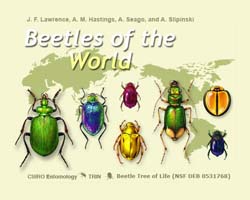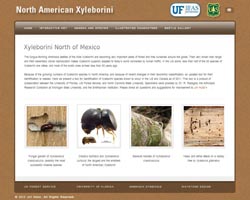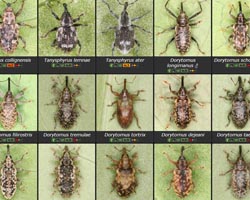Wood Boring Beetle Resource
Family Tool Search
Use the select menu to the left to view tools for a specific family or all families of wood boring beetles.
Bark and Ambrosia Beetles of Southeastern USA and Mexico
- Until recently, this site has been mainly directed to a narrow audience of persons who are students of the bark and ambrosia beetles. Recent changes to the section on the Bark and Ambrosia Beetles of the Southeastern U.S., especially improvements in the way that images are linked to species and the addition of distribution maps has made that section more useful to a wider group of people. In the relatively near future I expect to start adding more information on biology and habits to continue expanding in this direction.
- Taxonomic scope: Curculionidae
- Geographic scope: Nearctic, Neotropic
- Authors: Atkinson, T.H.
- Release date: 2011
Bark Beetle Genera of the United States
- Bark beetles (Coleoptera, Curculionidae, Scolytinae) are significant members of forest ecosystems worldwide, and some species may cause significant damage to economically important trees, particularly conifers. While most species only attack trees that are already dead or dying, a number of species attack healthy, living trees causing potentially lethal damage. One well known example of this is the mountain pine beetle, Dendroctonus ponderosae, which is currently destroying pine forests throughout the Mountain West.
- Taxonomic scope: Curculionidae
- Geographic scope: Nearctic
- Authors: Mercado, J.E.
- Release date: 2011
Xyleborini Ambrosia Beetles: An Identification Tool to the World Genera
- Xyleborini is the most important and species-rich tribe of fungus-farming ambrosia beetles. They are one of the most frequently intercepted organisms at ports of entry, and produced more invasive pests than all other ambrosia beetle groups combined. Yet no comprehensive classification has been designated, and no usable tools for identification exist. To address the void of identification tools for Xyleborini, and to assure the utility of the recently published reclassification of the group for forestry, quarantine facilities, and researchers, the author of the new classification and the USDA-APHIS-PPQ-CPHST have joined forces in turning the classification into an online, richly illustrated, user friendly identification and information resource.
- Taxonomic scope: Curculionidae
- Geographic scope: World
- Authors: Hulcr, J. and S.M. Smith
- Release date: 2010
Beetles of the World
- Beetles (order Coleoptera) are the most diverse and species-rich group of animals in the world. This fully-illustrated key allows users to identify adult beetles to the level of family, subfamily, and often to genus.
- Taxonomic scope: Anobiidae, Bostrichidae, Brentidae, Buprestidae, Cerambycidae, Curculionidae , Lymexilidae , Oedemeridae , Zopheridae
- Geographic scope: World
- Authors: Lawrence, J.F., A.M. Hastings, A. Seago, and A. Slipinski
- Release date: 2010
Wood Boring Beetle Families of the World
- Wood Boring Beetle Families delimits family-level taxa (both adults and larvae) of Coleoptera known to be wood borer.
- Taxonomic scope: Anobiidae, Bostrichidae, Brentidae, Buprestidae, Cerambycidae, Curculionidae , Lymexilidae , Oedemeridae , Zopheridae
- Geographic scope: World
- Authors: Cline, A.R., M.A. Ivie, C.L. Bellamy, and J. Scher
- Release date: 2009
Bark Beetles of the Southeastern United States
- Bark beetles can be a difficult group for identification. This tool is designed for first responders with minimal entomological training. It is also rigorous enough for entomology students and professionals. Numerous illustrations and a convenient glossary of terms should simplify some of the normal difficulties. The matrix design makes it possible for the user to choose the identification characters that are most visible or most familiar rather than being required to struggle with the authors' designated characters to work through the key. Sometimes only two or three characters are required, rather than 13-18 that might be needed in a normal dichotomous key.
- Taxonomic scope: Curculionidae
- Geographic scope: Nearctic
- Authors: Baker, J.R., J. LaBonte, T. Atkinson, and S. Bambara
- Release date: 2009
A Screening Aid for the Identification of the Walnut Twig Beetle, Pityophthorus juglandis Blackman
- The walnut twig beetle (WTB), Pityophthorus juglandis Blackman (Scolytidae), is a small (~2 mm long) bark beetle native to the southwestern United States (AZ, CA and NM) and northern Mexico (Chihuahua). Recently, WTB has been linked to decline and death of walnut trees (Juglans) in several western states, including states outside its native range, e.g., CO and OR.
- Taxonomic scope: Curculionidae
- Geographic scope: Nearctic
- Authors: LaBonte, J.R. and R.J. Rabaglia
- Release date: 2008
Screening Aid to Separate Scolytinae Bark Beetles from other Similar Appearing Bark Beetles
- Description text coming soon.
- Taxonomic scope: Curculionidae
- Geographic scope: Nearctic
- Authors: Brown, B.
- Release date: 2008
Screening Aid for Eastern Scolytinae
- This screening aid is not intended to replace a full course in the identification of Scolytinae nor is it a comprehensive treatment of the Scolytines of the eastern USA. It is intended to enable individuals responsible for sorting and identifying large volumes of wood boring insect trap samples to quickly and efficiently sort out the most common species encountered in samples from surveys in the eastern USA. This aid will be most reliable east of the Midwest and north of the southern edge of the U.S. (e.g., southern Florida).
- Taxonomic scope: Curculionidae
- Geographic scope: Nearctic
- Authors: LaBonte, J.R., S.A. Valley, E.R. Hoebeke, and R.J. Rabaglia
- Release date: 2008
Screening Aid for Western Scolytinae
- This screening aid is not intended to replace a full course in the identification of Scolytinae nor is it a comprehensive treatment of the Scolytines of the western USA. It is a means by which individuals responsible for sorting and identifying large volumes of wood boring insect trap samples can quickly and efficiently sort out the most common species from similar surveys in the Pacific Northwest, and, to a lesser extent, the West in general. Specimens from other areas may not be addressed by the aid.
- Taxonomic scope: Curculionidae
- Geographic scope: Nearctic
- Authors: LaBonte, J.R., S.A. Valley, and J.J. Vlach
- Release date: 2008
Screening Aids for Exotic Bark Beetles in the Northeastern United States
- These screening aids were simplified by restricting the species treated to native bark beetles that are from a limited geographic area (i.e., the Northeastern Region) and are similar to the exotic target. The keys, in particular, may not be useful for screening survey samples from outside the northeaster U.S.
- Taxonomic scope: Curculionidae
- Geographic scope: Nearctic
- Authors: Cavey, J., Passoa, S. and D. Kucera
- Release date: 2006
North American Xyleborini
- The fungus-farming Ambrosia beetles of the tribe Xyleborini are becoming very important pests of forest and tree nurseries around the globe. Their very broad host range and their essentially clonal reproduction makes Xyleborini superbly adapted to today's world connected by human traffic. In the US alone, less than half of the 50 species of Xyleborini are native, and most of the exotic ones arrived less than 50 years ago. Because of the growing numbers of Xyleborini species in North America, and because of recent changes in their taxonomic classification, an updated tool for their identification is needed. Here we present a tool for identification of Xyleborini species known to occur in the US and Canada as of 2011.
- Taxonomic scope: Curculionidae
- Geographic scope: Nearctic
- Authors: Hulcr, J.
- Release date: 2012
Curculionidae: The beetle fauna of Germany
- The weevils (Curculionidae) are a very large family. With more than 60,000 scientifically described species worldwide, the weevils are the largest beetle family and the largest family in the animal kingdom. One out of five beetles and one out of 30 animals is a weevil. In Germany 780 species are known to occur. The phytophagous species are found on various plants. Often the weevil is strictly associated with a certain plant.
- Taxonomic scope: Curculionidae
- Geographic scope: Palearctic
- Authors: Benisch, C.
- Release date: 2007





